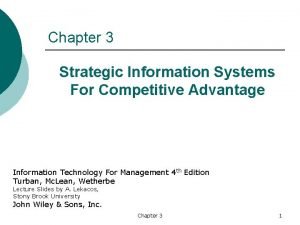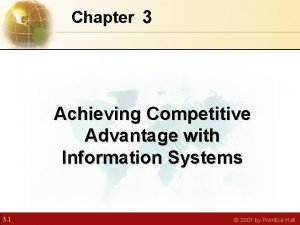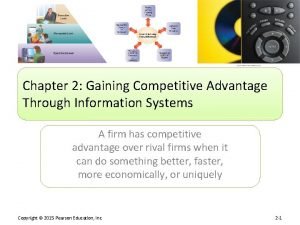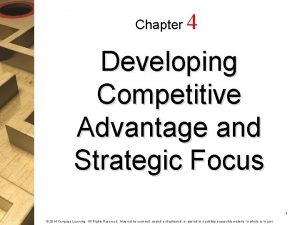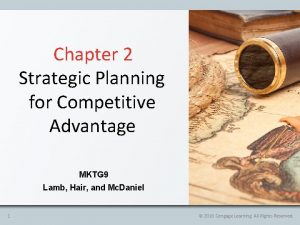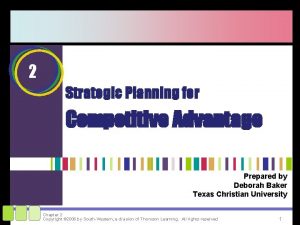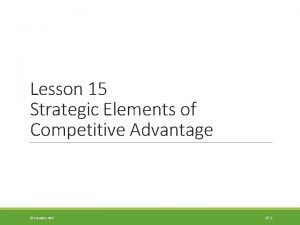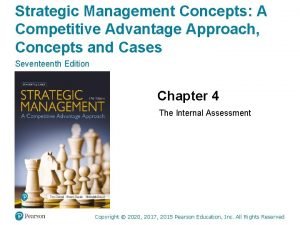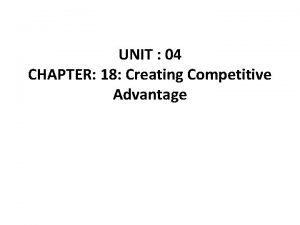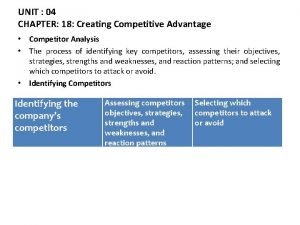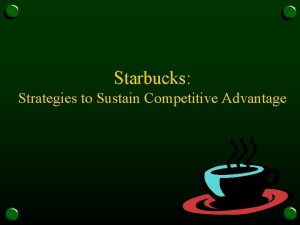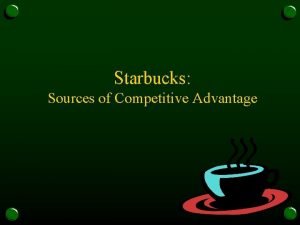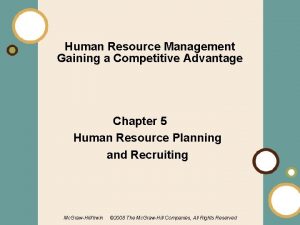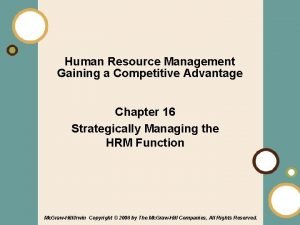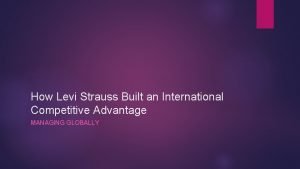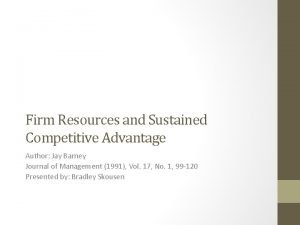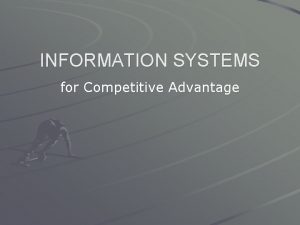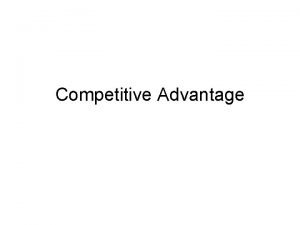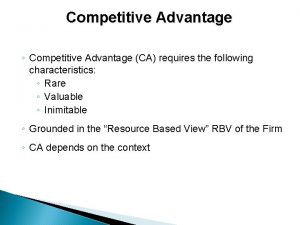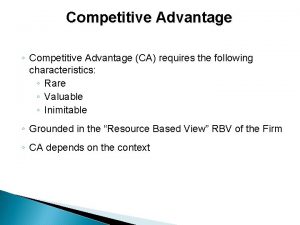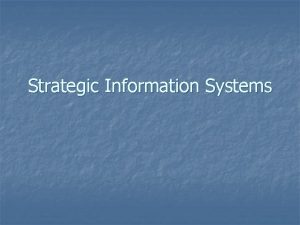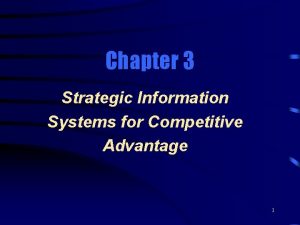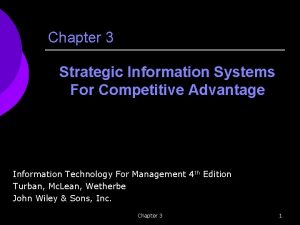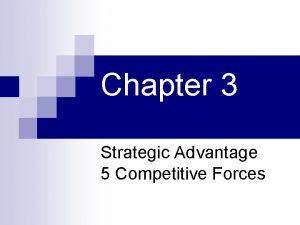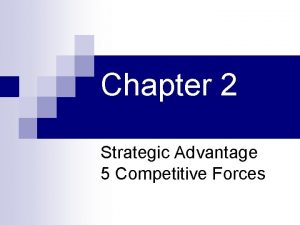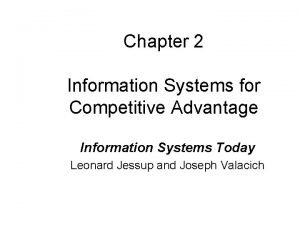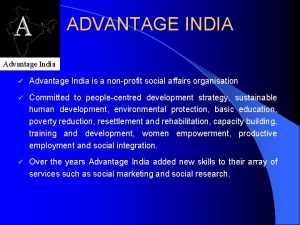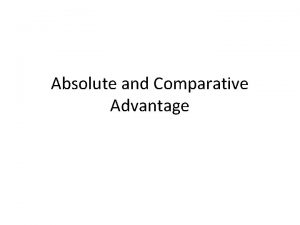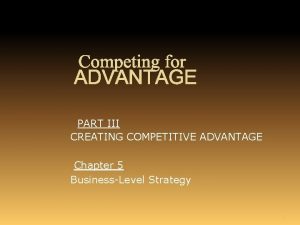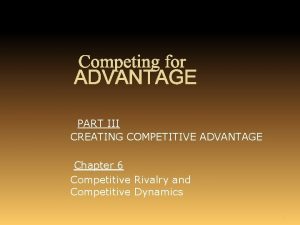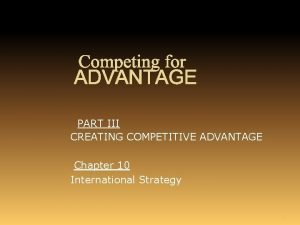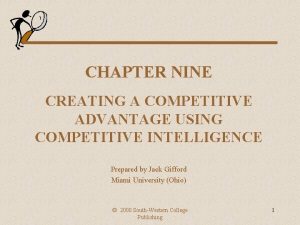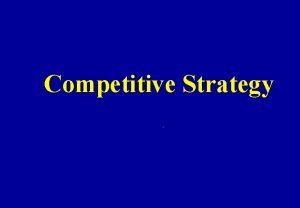Strategic Information Systems for Competitive Advantage 1 Learning






















- Slides: 22

Strategic Information Systems for Competitive Advantage 1

Learning Objectives § § Describe strategic information systems (SIS) and explain their advantages. Describe Porter’s competitive forces model & how IT helps companies improve their competitive positions. Describe Porter’s value chain model and its relationship to information technology. Describe several other frameworks that show IT supports the attainment of competitive advantage. 2

Learning Objectives (cont. ) § § Describe and understand the role of web-based SIS and the nature of competition in the digital age. Describe global competition and its SIS framework. Describe representative strategic information systems and the advantage they provide to organizations. Discuss implementation issues including possible failures of SIS. 3

Strategic Information Systems (SISs) n SIS n n n Characterized by its ability to significantly change the manner in which business is done. It can also change the goal, processes, products, or environmental relationships to to help an organization gain a competitive advantage. An organization competitive strategy is the search of a competitive advantage in an industry. n Cost, quality, or speed. 4

Strategic Information Systems (SISs) n SIS Definition n n Systems that organizations totally depends on Systems that has very impact on organization business processes, operation, and the bottom line. Internally focused or externally focused Can be applied within the organization or across the organization 5

Strategic Information Systems (SISs) n Sustaining Strategic Advantage n n This systems are design from the beginning to facilitate competitive advantage. Today it is more difficult to sustain a competitive advantage with the use of IT for a long period of time. 6

The Role of IT Ø IT creates applications that provide strategic advantages to companies Ø E. g. Federal Express was the first to company to use the tracking system Ø IT is a competitive weapon Ø IT supports strategic change, e. g, re-engineering Ø Ø Cycle time reduction, streamlining, CASE, etc. IT networks with business partners Ø B 2 B Ø IT provides cost reduction Ø IT provides competitive business intelligence 7

Porter’s 5 Competitive Forces Ø The threat of entry of new competitors. Ø The bargaining power of suppliers. Ø The bargaining power of customers (buyers). Ø The threat of substitute products or services. Ø The rivalry among existing firms in the industry. 8

Porter’s Model in Action 9

Response Strategies (Porter, 1985) COST LEADERSHIP DIFFERENTATI ON Providing products and/or Being unique in services at the industry lowest cost in the industry. FOCUS Selecting a niche market and achieving cost leadership and/or differentation. 10

Response Strategies (added by Porter and others) GROWTH Increasing market share, acquiring more customers or selling more products IMPROVE INTERNAL EFFICIENCY To improve employee and customer satisfaction ALLIANCES Working with business partners to create synergy & provide opportunities for growth CRM Customer-oriented approaches, e. g. the customer is king (queen) INNOVATION Developing new products & services 11

The Value Chain Support activities Primary activities Inbound logistics Operations Outbound logistics Marketing and Sales Service Corporate infrastructure Human resources management Technology Development Procurement Materials receiving, storing, and distribution to manufacturing premises Transforming inputs into finished products. Storing and distributing products Promotions and sales force Service to maintain or enhance product value Support of entire value chain, e. g. general management planning, financing, accounting, legal services, government affairs, and QM Recruiting, hiring, training, and development Improving product and manufacturing process Purchasing input 12

VALUE SYSTEM § A firm’s value chain is part of a larger stream of activities, which Porter calls a “Value System”. § § § Includes the suppliers that provide the necessary inputs AND their value chains. Applies to both products & services, for any organization, PUBLIC or PRIVATE. Is the basis for the Supply Chain Management. 13

The Value Chain Model § The Value System Model is used to: § § § Evaluate a company’s process and competencies. Investigate whether adding IT supports the value chain. Enable managers to assess the information intensity and the role of IT. 14

Strategic Information Systems Frameworks n A framework for SIS is a descriptive structure that helps us understand clarify the relationships among strategic management and IT. n E. g. n n Bakos and Treacy Framework Mc. Farlan Application Portfolio Analysis Framework 15

Bakos & Treacy Framework 16

Mc. Farlan’s Portfolion Framework (1984) For Analyzing Existing, Planned & Potential Information Systems 17

Categories of Strategic Relevance and Impact A contingency appropriate to IT management. High Factory Strategic Impact of existing IT system IT are important but they are not fundamental to the firms ability to compete. Support Strategic Impact of IT on operations and future strategy is low. Low Strategic Totally depending on it Turnaround Not absolutely depending on totally uninterrupted, fast response-time. High Strategic Impact of IT applications under development 18

SIS Implementation § Major Issues to be Considered: § Justification § § § Justifying SIS may be difficult due to the intengible nature of their benefits. Risks & Failures § The magnitude, complexity, continuous changes in technology and business environment may result in failures. Finding appropriate SIS § Identifying appropriate SIS is not a simple task. 19

Sustaining SIS & Strategic Advantage § § A Major problem that companies face is how to sustain their SIS competitive advantage. 3 Major approaches = § Create inward systems which are not visible to competitors. § § Provide a comprehensive, innovative & expensive system that is difficult to duplicate. Combine SIS with structural changes. This would include business processes, reengineering & organizational transformation. 20

Managerial Issues ü Implementing SIS Can Be Risky. The investment involved in implementing Strategic Information Systems (SIS) is high. ü Strategic Information Systems Requires Planning for an SIS is a major concern of organizations. 21

Managerial Issues (cont. ) ü Sustaining Competitive Advantage Is Challenging. As companies become larger and more sophisticated, they develop resources to duplicate the systems of their competitors quickly. ü Ethical Issues. Gaining competitive advantage through the use of IT may involve unethical or even illegal actions. Companies can use IT to monitor the activities of other companies and may invade the privacy of individuals working there. 22
 Strategic information system for competitive advantage
Strategic information system for competitive advantage Achieving competitive advantage with information systems
Achieving competitive advantage with information systems Gaining competitive advantage through information systems
Gaining competitive advantage through information systems Developing a firm's strategy canvas focuses on
Developing a firm's strategy canvas focuses on Dream box
Dream box Chapter 2 strategic planning for competitive advantage
Chapter 2 strategic planning for competitive advantage Strategic planning for competitive advantage
Strategic planning for competitive advantage Strategic planning for competitive advantage
Strategic planning for competitive advantage Strategic elements of competitive advantage
Strategic elements of competitive advantage Strategic management a competitive advantage approach
Strategic management a competitive advantage approach Which market is the least competitive
Which market is the least competitive Pharmacology introduction
Pharmacology introduction Competitive dynamics examples
Competitive dynamics examples Value creation strategy
Value creation strategy Chapter 18 creating competitive advantage
Chapter 18 creating competitive advantage Jay b barney
Jay b barney Starbucks competitive strategy
Starbucks competitive strategy What is starbucks competitive advantage
What is starbucks competitive advantage Human resource management gaining a competitive advantage
Human resource management gaining a competitive advantage Downsizing
Downsizing Human resource management gaining a competitive advantage
Human resource management gaining a competitive advantage Levis competitive advantage
Levis competitive advantage Firm resources and sustainable competitive advantage
Firm resources and sustainable competitive advantage
